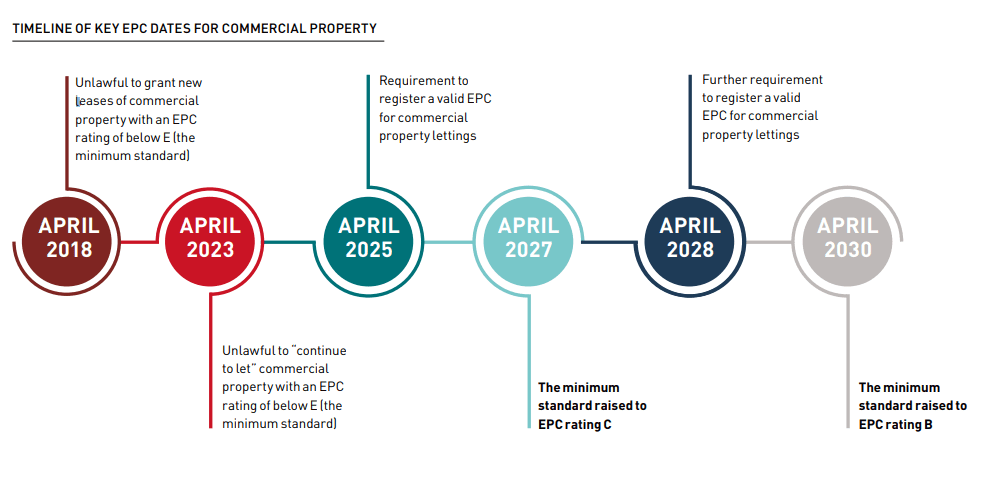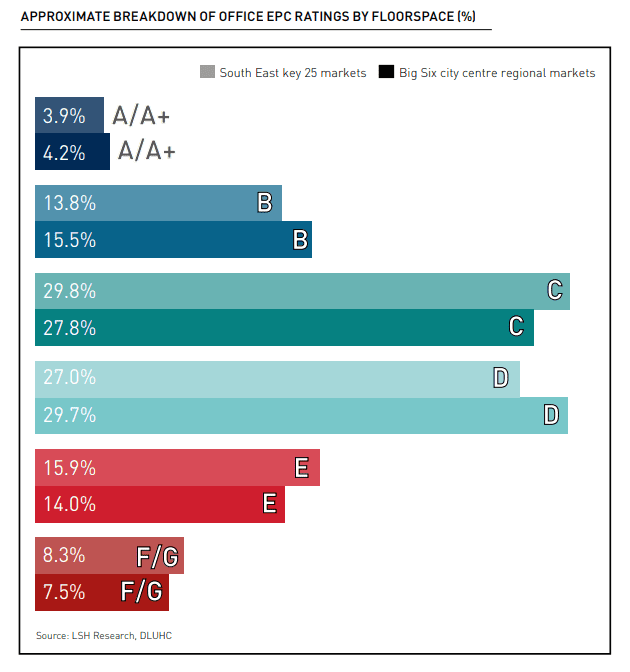How can landlords ensure their office buildings comply with Minimum Energy Efficiency Standards (MEES)? Over the coming years, many landlords face an uphill struggle to ensure their office buildings comply with the MEES – but landlords need not despair.
The tightening of the MEES has been well-documented,with the most recent milestone being extended to prohibit landlords from leasing commercial buildings with an EPC rating of F or G since April 1, 2023.
The minimum standards are scheduled to further tighten over the coming years. The next key milestone, scheduled for April 2027, will see the rules apply to any building with an EPC rating of below C, before rising once again to a minimum threshold of B ratings by April 2030.
The scale of the challenge
Assuming the MEES timeline is followed through, many landlords of regional offices have a relatively tight timeframe to ensure their assets remain compliant. Lambert Smith Hampton’s analysis of the government’s EPC Register gives a sense of the scale required to meet these tightening standards.
Approximately 8% of existing floorspace is EPC rated F or G and is, therefore, now unlettable in 25 key South East region markets due to the recent step-up in standards affecting a significant minority of office buildings.
The tightening standards in the South East markets will result in a significant impact on floorspace, with a further 43% of stock expected to be affected by April 2027, rising to a total figure of circa 80% by April 2030.
Alarming as the above analysis may sound, landlords can avoid panic by planning ahead.
The starting point is to heed the recommendations within an EPC report. An EPC Plus is a genuine benefit in that it provides recommendations that can be planned and implemented, allowing landlords to build up and/or deploy capital expenditure over phases, rather than all in one go. The EPC Plus report will consider the lifecycle of equipment in a building and helps to develop a sequenced plan for equipment replacement rather than hasten the obsolescence of equipment unnecessarily.
Planning and budgeting
Once the EPC recommendations are considered, the planning and budgeting phase of the works can be set out. There is, however, little time to waste here, as a valid EPC is required by April 1, 2025. With expert guidance, a review can assess what needs to be done and when – for a single asset or whole portfolio of properties if required. Recommendations are costed, while future costs are indexed to account for inflation.
Crucially, an EPC Plus report will indicate the recommendations that fall outside the so-called seven- year rule. If the payback period of a recommendation takes more than seven years, it need not be carried out. If all recommendations are within this period, no further work is needed, and properties can be placed on the government’s exemption register.

Use the experts
Landlords are advised to instruct a reputable company for EPC commissioning and remediation advice. This will provide the basis to carry out the work required at the optimum time, saving money and ensuring compliance with statutory requirements.
An inaccurate certificate risks a disastrous starting point for setting out improvements. It is vital that default figures are not used in the calculations. The correct Coefficient of Performance, heating and cooling efficiency ratios or boiler efficiency can significantly impact EPC ratings and subsequent recommendations.
There are several quick wins than can help elevate a building’s EPC rating without requiring serious work to the property. Lighting is one area of low hanging fruit for offices. Replacing old T8 or tungsten fittings with LED fittings can significantly help in achieving a higher EPC rating due to the high weighting in the assessments.
If a landlord’s existing certificate is more than five years old, a new EPC may be beneficial for the building. The weighting and fuel factor for electricity has much improved since 2022, meaning a re-assessment could potentially result in a better rating without doing anything at all to the building. If the building is gas-fuelled, however, the re-assessed EPC rating may be less favourable.
The path that leads to a B rating may be daunting but, armed with a proper plan, the destination is not insurmountable.

Just one part of the puzzle
With a broad range of in-house specialists, Lambert Smith Hampton provides strategic advice to enable investors, owners and occupiers to fully maximise their ESG opportunities and minimise risks in their real estate, by creating solutions at an asset and portfolio level for each stage in their journey towards their ESG and net zero goals and aspirations.
At one end of the scale, this involves obtaining an EPC Plus report and incepting a plan to implement the report recommendations. At the other end of the scale, this can involve a complete retrofit of a property to update fuel sources, replace inefficient plant and renew building fabric all with the global aim of increasing energy efficiency.
Contact Lambert Smith Hampton on 01908 604630, email BSwingler@lsh.co.uk or visit the website www.lsh.co.uk.















